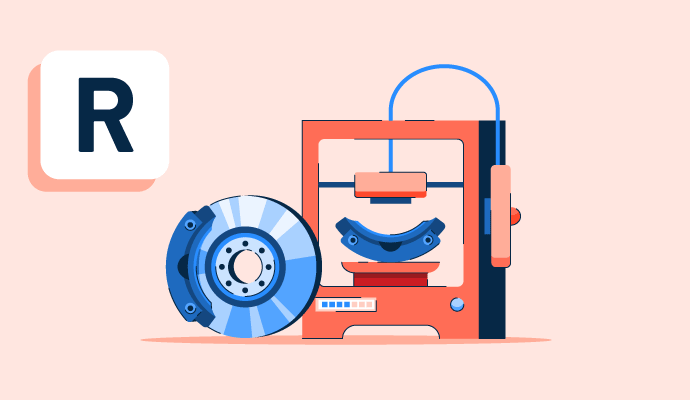What is rapid prototyping?
Rapid prototyping is a product development approach to building a quick and affordable physical representation of a concept or idea. The primary objective is to test and improve before moving forward with more expensive and time-consuming manufacturing procedures.
With rapid prototyping, a virtual model is typically created using computer-aided design (CAD) software and turned into a physical prototype using a 3D printer or another prototyping software. Designers and engineers use rapid prototyping to easily alter the design in response to testing results and user feedback.
Types of rapid prototyping
Rapid prototyping is valuable for exploring and testing different ideas and concepts. It tests a product's usability and functionality in a more realistic setting. Rapid prototyping is of two types, namely:
- Low fidelity (Lo-Fi): These are simple, basic, rough sketches, mockups, or wireframes that users can create cost-effectively. These prototypes are often created early in the design process to explore different ideas and concepts. Lo-Fi prototypes are usually not interactive and don’t have a high level of detail or accuracy.
- High fidelity (Hi-Fi): These are more advanced and detailed prototypes created later in the design process. These prototypes are often interactive, functional, and designed to resemble the final product closely. It can test the usability and functionality of the product and identify and fix any design flaws before the final product is produced.
Benefits of rapid prototyping
Rapid prototyping offers many benefits to streamline the product development process to help achieve a better result. Below are some popular rapid prototyping benefits:
- Faster development cycles. Rapid prototyping allows for quick and easy design iteration, which can help speed up the development process.
- Reduced development costs. Users can catch design flaws and issues early in the development cycle, reducing costs.
- Improved communication and collaboration. Teams can share physical prototypes with other members, clients, and stakeholders, facilitating communication and collaboration, leading to better results.
- Better design validation. Designers test and validate their designs, ensuring the final product meets the desired specifications and requirements.
- Increased flexibility. Rapid prototyping enables more flexibility in design changes and modifications, making the process quick and reliable.
- Better product quality. By catching design flaws and issues early in the development cycle, rapid prototyping helps improve the final product’s quality.
Rapid prototyping technologies
Many rapid prototyping technologies are available, each with unique strengths and limitations. Here are some common types of rapid prototyping:
- Stereolithography (SLA) uses a UV laser to cure a liquid resin, layer by layer, to create a solid object.
- Fused deposition modeling (FDM) builds items layer by layer by extruding plastic filament.
- Selective laser sintering (SLS) melts powdered materials into solid objects.
- Computerized numerical control (CNC) machining is a subtractive manufacturing process that involves using a computer-controlled machine to cut, grind, or drill away material to produce a physical object.
- Vacuum casting creates a prototype mold, and liquid resin is poured into the mold to produce a real-world prototype.
- Sheet metal forming bends and slices sheet metal to produce something tangible.
- Injection molding injects molten material into a mold cavity during the manufacturing process.
- Direct metal laser sintering (DMLS) uses a high-powered laser to fuse powdered metal into a solid object.
Process of rapid prototyping
The rapid prototyping process can be repeated multiple times throughout the product development cycle to refine the design. This will help ensure the final product meets the desired specifications and requirements.

A rapid prototyping process typically involves the following steps:
- Design: Designers can use CAD software to produce a digital design. Typically, an engineer or product designer would create this design.
- Prototype creation: Following the digital design completion, the prototype is produced using numerous rapid prototyping techniques, such as 3D printing or CNC milling.
- Testing and evaluation: Users must test and evaluate the prototype to find any design defects or problems. Functional, stress or user testing may be involved in this.
- Iteration: Users can adjust the design and build a new prototype based on the findings of testing and evaluation. Until the design is complete, this iteration process is repeated several times.
- Production: After the final prototype is approved, users can deliver the product using conventional manufacturing processes or improve it using rapid prototyping techniques.
Traditional prototyping vs. rapid prototyping
Businesses have used traditional prototyping for years to conceive, design, and produce precise models of diverse items. This technique needs years of expertise and hours of labor. A simple blueprint can temporarily prototype sophisticated components using equipment like CAD software, competent machinists, or pen and paper. Machinists can swiftly construct a full or partial model with thorough scrutiny and this technique.
Rapid prototyping takes a new method of making 3D models and components over traditional prototyping. The materials are milled on a CNC machine and created using business software with 3D printing stereolithography. It’s the more complicated of the two prototyping alternatives since it may produce nearly similar prototypes rather than the more basic mockup that comes with traditional prototyping.
Before a product is sent to production, rapid prototyping aids in visualizing digitally rendered designs. Additionally, it’s a fantastic way to test concepts and design ideas faster and more efficiently.
Learn more about 3D printing and discover how to construct three-dimensional objects layer by layer.

Sagar Joshi
Sagar Joshi is a former content marketing specialist at G2 in India. He is an engineer with a keen interest in data analytics and cybersecurity. He writes about topics related to them. You can find him reading books, learning a new language, or playing pool in his free time.

